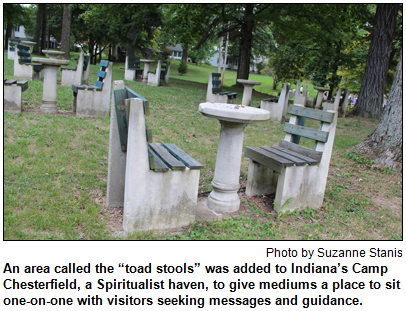Saturdays, noon to 1 p.m. ET on WICR 88.7 FM.
Or listen live from anywhere on WICR
Online!
Oct. 10 show
Camp Chesterfield and Spiritualism history
|
Just north of Anderson on the banks of the White River is a historic 34-acre enclave that has long been known as a "hub of Spiritualism."
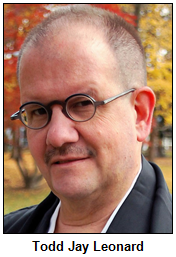 Camp Chesterfield, the home for more than 120 years of the Indiana Association of Spiritualists, consists of 65 buildings. They include historic cottages (such as cabins for mediums), two hotels, folk art shrines and the spacious Cathedral of the Woods.
Camp Chesterfield, the home for more than 120 years of the Indiana Association of Spiritualists, consists of 65 buildings. They include historic cottages (such as cabins for mediums), two hotels, folk art shrines and the spacious Cathedral of the Woods.
 Spiritualism attracted a huge national following beginning in the mid-1800s; it grew particularly during eras of war - such as the Civil War, Spanish-American War and World War I - when, as the Indiana Preservationist puts it, "the bereaved sought communication with those they lost."
Spiritualism attracted a huge national following beginning in the mid-1800s; it grew particularly during eras of war - such as the Civil War, Spanish-American War and World War I - when, as the Indiana Preservationist puts it, "the bereaved sought communication with those they lost."
Indiana Landmarks has placed Camp Chesterfield on its "10 Most Endangered" list. That's because many of the camp's historic buildings, such as the Sunflower Hotel, built in 1914, stand vacant or, in the case of other structures, are underused.
Camp Chesterfield is listed on the National Register of Historic Places because of its significance as a spiritualist camp of the type that was widespread throughout the East and Midwest during the early 1900s.
To explore the history of Camp Chesterfield and of Spiritualism, which is defined in The Spirits of Lily Dale (Glade Press, 2010) as "the philosophy, science and religion of continuous life," Nelson will be joined in studio by two guests:
- Rev. Todd Jay Leonard, an ordained Spiritualist minister and Camp Chesterfield's historian. Todd also is a university professor; he splits his time between Camp Chesterfield and Japan, where he teaches cross-cultural understanding and English.
- And Suzanne Stanis, Indiana Landmarks' director of heritage education and a board member of the Friends of Camp Chesterfield Foundation, a nonprofit formed to preserve and restore the historic camp.
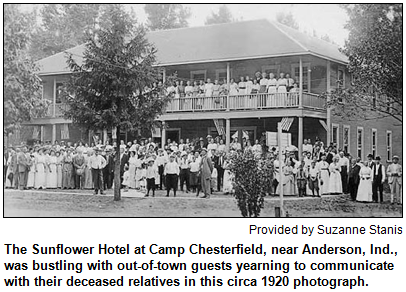 The camp includes a memorial dedicated to "the world's greatest religious leaders" that features limestone busts of Buddha, Jesus, Mohammed, Zeus and others. There also is a memorial to Native Americans, as well as "toad stools" - stone seating areas where mediums once gave outdoor readings.
The camp includes a memorial dedicated to "the world's greatest religious leaders" that features limestone busts of Buddha, Jesus, Mohammed, Zeus and others. There also is a memorial to Native Americans, as well as "toad stools" - stone seating areas where mediums once gave outdoor readings.
Seances have been conducted for generations at Camp Chesterfield. According to the Indiana Preservationist, Spiritualists believe it's possible to "communicate with the dead, especially with the aid of skilled mediums."
According to The Spirits of Lily Dale (the title refers to the center of the Spiritualist movement in western New York), many leaders of the anti-slavery, women's rights, temperance, prison reform and labor reform movements were involved in Spiritualism.
Camp Chesterfield began as a summer tent camp in the 1890s. In the beginning, according to Chesterfield Lives, a privately published history of the camp, visitors had to bring "their own camping equipment and hay for horses."
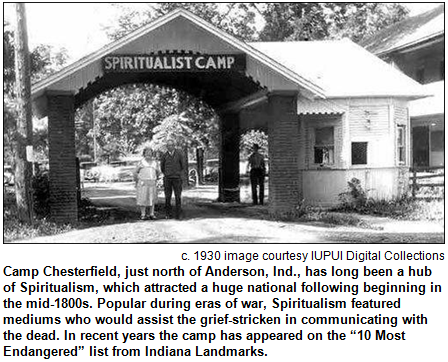 "Almost every town and area had a Spiritualist organization or group of people who gathered together for meetings," according to The Spirits of Lily Dale, referring to the late 19th and early 20th centuries. Sometimes thousands of people would gather at conventions and seasonal camp meetings.
"Almost every town and area had a Spiritualist organization or group of people who gathered together for meetings," according to The Spirits of Lily Dale, referring to the late 19th and early 20th centuries. Sometimes thousands of people would gather at conventions and seasonal camp meetings.
At Camp Chesterfield, a chapel in the woods serves as the setting for "message services" as well as weddings and funerals; in addition to the chapel, the spacious Cathedral of the Woods was built in 1954. Six years earlier, the Western Hotel opened to supplement the Sunflower Hotel.
"With a shrinking budget and congregation, the Indiana Association of Spiritualists struggles to maintain Camp Chesterfield," the Indiana Preservationist notes.
In addition to Camp Chesterfield, other historic sites on the "10 Most Endangered" list include the Indiana Medical History Museum and the once-lavish but long-deteriorating Rivoli Theater on the eastside of Indianapolis.
Learn more:
- A Brief History of Spiritualism in Indiana - Indiana Magazine of History.
- Camp Chesterfield - IUPUI Digital Collection.
- Photo gallery of Camp Chesterfield - Indiana Landmarks.
Roadtrip - Historic New Albany, Ind.
 Our guest Roadtripper is the distinguished Dr. James Glass, principal of Historic Preservation & Heritage Consulting. Jim suggests a Roadtrip to New Albany in the southern part of Indiana along the Ohio River.
Our guest Roadtripper is the distinguished Dr. James Glass, principal of Historic Preservation & Heritage Consulting. Jim suggests a Roadtrip to New Albany in the southern part of Indiana along the Ohio River.
New Albany, he tells us, was the largest city in Indiana in 1850 with 8,181 people (Indianapolis had 8,012), and was also the second-largest city along the Ohio and Mississippi Rivers in the building of steamboats before the Civil War.
A few other quick facts:
- New Albany shipyards built 249 steamboats between 1817 and 1854.
- New Albany also was known for its plate glass (Washington DePauw ran one of the largest plate-glass factories in the United States) and fine wood veneers after 1865.
- Mansion Row along Main Street contains a superb collection of 19th-century mansions in a variety of architectural styles. The most impressive is the Culbertson Mansion, operated by the Indiana State Museum and State Historic Sites, a grand residence designed in the Second Empire Style.
- New Albany also was a center of the Underground Railroad, in which both freed African Americans and white citizens aided freedom-seeking enslaved people to cross the Ohio and find their way north to freedom. The Carnegie Center for Art and History contains exhibits on the Underground Railroad and contemporary art in the New Albany area.
- The Division Street School is a restored 1885 school in which African-American students were educated during the segregation era; visitors can experience the educational experience of the students.
- Jim also writes a monthly column about history for The Indianapolis Star; here is a link to his column New Albany's Rich History Shines Again.
History Mystery
Anderson, the city closest to Camp Chesterfield, was named after a Native American leader. Chief William Anderson was a widely admired leader of an Indian tribe that lived along the banks of the White River and in the woodland areas where such towns as Muncie, Noblesville and Anderson later were founded.
 In fact, the village of Anderson initially was known as Anderson Town in an even more specific reference to Chief William Anderson.
In fact, the village of Anderson initially was known as Anderson Town in an even more specific reference to Chief William Anderson.
In what has been described as a forced removal, the tribe left Indiana during the 1820s. Chief Anderson and the rest of the Native American tribe eventually ended up in Kansas.
Question: Name the tribe of Native Americans.
Please do not call into the show until Nelson has posed the question on the air. The prize pack includes a gift certificate to Iozzo's Garden of Italy in downtown Indy, courtesy of Visit Indy, two passes to Glo Golf in the Circle Centre Mall in downtown Indianapolis, courtesy of Glo Golf, and two tickets to the Indiana History Center featuring the new exhibit You Are There 1816: Indiana Joins the Nation, courtesy of the Indiana Historical Society.
Your Hoosier History Live! team,
Nelson Price, host and
creative director
Molly Head, producer, (317)
927-9101
Richard Sullivan, webmaster
and tech director
Pam Fraizer, graphic
designer
Garry Chilluffo, media+development director
Please tell our sponsors that you appreciate their support: Indiana Authors Award | Indiana Historical Society | Indianapolis Scottish Highland Games & Festival | Lewis Kappes Attorneys at Law | Lucas Oil | Story Inn

 Acknowledgments to Monomedia, Visit Indy, WICR-FM, Fraizer Designs, Heritage Photo & Research Services, Derrick Lowhorn and many other individuals and organizations. We are an independently produced program and are self-supporting through organizational sponsorships and individual contributions. We do not receive any government funding. Visit our website to learn how you can support us financially. Also, see our Twitter feed and our Facebook page for regular updates.
Acknowledgments to Monomedia, Visit Indy, WICR-FM, Fraizer Designs, Heritage Photo & Research Services, Derrick Lowhorn and many other individuals and organizations. We are an independently produced program and are self-supporting through organizational sponsorships and individual contributions. We do not receive any government funding. Visit our website to learn how you can support us financially. Also, see our Twitter feed and our Facebook page for regular updates.
Oct. 17 show
Persian/Iranian heritage in Indiana
Iran has been in the headlines continually. So it is timely for our rotating series about the ethnic heritage of Indiana - which has explored a vast range from German, Irish and Scottish to Cuban, Columbian/Venezuelan and Russian immigration - to look at the Persian and Iranian heritage in the Hoosier state.
Nelson's guests will include Cyrus Jafari, a Realtor and entrepreneur in Indianapolis who grew up in Iran and immigrated at age 24 in 2001. 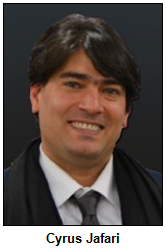 Cyrus, past president of the Society for the Preservation of Persian Culture, is the owner of Showcase Realty. He owns the former Earth House (a historic structure which once housed the Lockerbie United Methodist Church) and eventually hopes to open a Persian coffeehouse there.
Cyrus, past president of the Society for the Preservation of Persian Culture, is the owner of Showcase Realty. He owns the former Earth House (a historic structure which once housed the Lockerbie United Methodist Church) and eventually hopes to open a Persian coffeehouse there.
"Basically, people who have come from Iran are in one of two groups," Cyrus says. "The first group came before the revolution in 1977 and often were supporters of the shah. The newer group, people like me, grew up in Iran after that and never experienced what the country was like in the past."
According to Peopling Indiana: The Ethnic Experience (Indiana Historical Society Press, 1996), few Iranians came to Indiana - or even to the United States - before 1900. During the last 50 years, though, many have come to study medicine, engineering and other fields at universities.
Although Cyrus grew up in Iran, he was born in the United States because his father came to study electrical engineering.
During his youth in the historic Iranian city of Isfahan, Cyrus met his wife Nasim. She immigrated several years after Cyrus and is a chef at the Eagle's Nest restaurant in downtown Indy.
Because of the volatile relationship between Iran and the United States, Cyrus reports that some immigrants are reluctant to identify their heritage.
"If you are ashamed to be Iranian, you tend to call yourself Persian," he says.
Cyrus, who has dual citizenship, has been able to travel freely in and out of his homeland and visited Iran last year.
Learn more:
- Columbia University, Center for Iranian Studies.
- Indianapolis, A City of Immigrants - by M. Teresa Baer, page 45, Indiana Historical Society.
- Statistics about Immigrants from Indianapolis - Immigrant Welcome Center.
- The Iranian Americans - PBS documentary.
© 2015 Hoosier History Live! All rights reserved.
Hoosier History Live!
P.O. Box 44393
Indianapolis, IN 46244
(317) 927-9101

